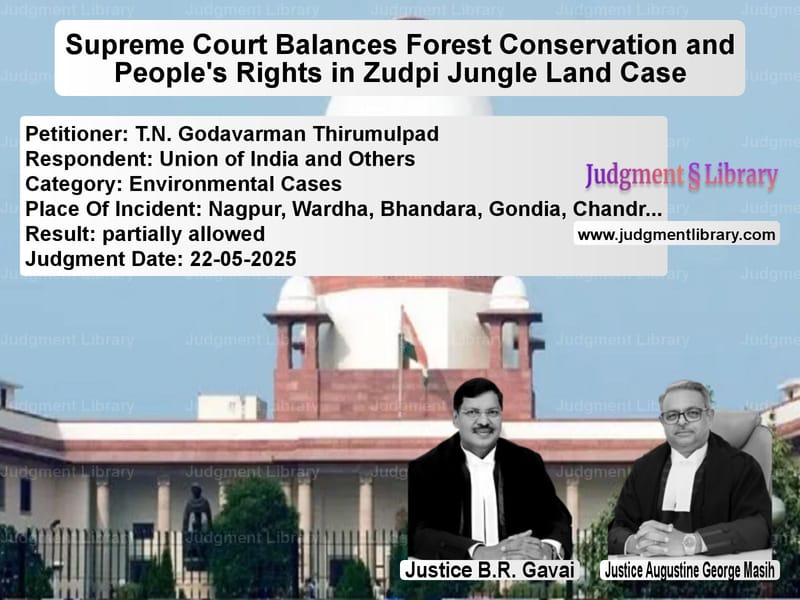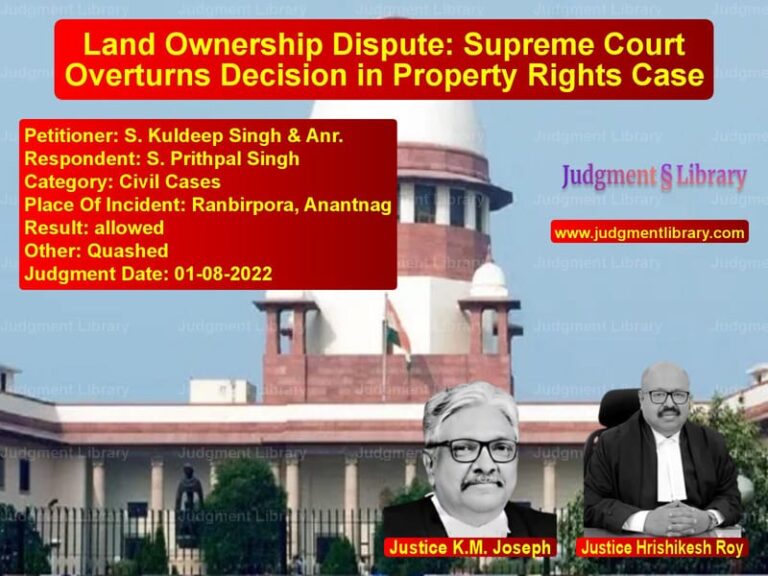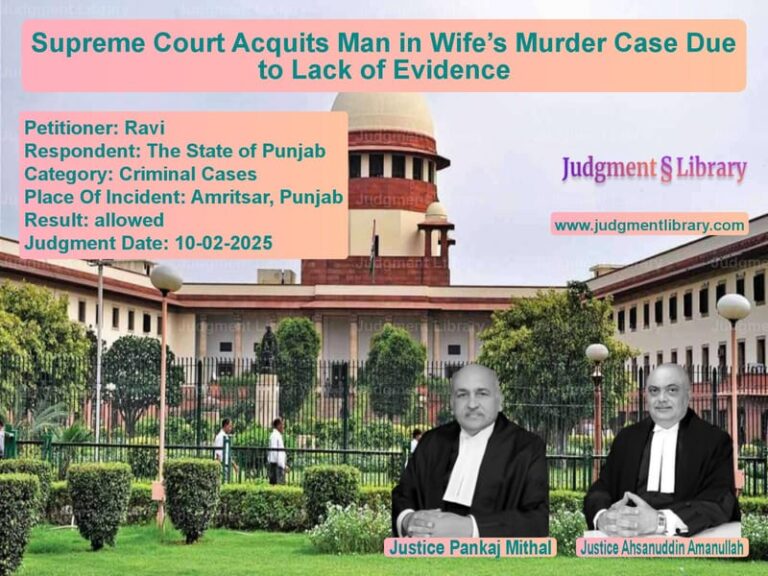Supreme Court Balances Forest Conservation and People’s Rights in Zudpi Jungle Land Case
In a landmark judgment that balances environmental protection with the rights of lakhs of citizens, the Supreme Court of India has delivered a nuanced verdict on the contentious issue of Zudpi Jungle lands in Maharashtra’s Vidarbha region. The case, which has been pending for decades, involved complex questions about forest conservation, historical land use, and the fundamental rights of people who have lived on these lands for generations.
The legal battle centered around 86,409 hectares of land classified as Zudpi Jungle in six districts of Eastern Vidarbha – Nagpur, Wardha, Bhandara, Gondia, Chandrapur and Gadchiroli. The State of Maharashtra argued that though these lands were recorded as Zudpi Forest in revenue records, they were never actually forest lands and had been used for various non-forestry purposes like residential areas, agricultural fields, government offices, public schools, and primary health centers for several decades.
The State’s counsel, Shri Siddharth Dharmadhikari, made a compelling argument: “Though these lands have been recorded in the revenue records as Zudpi Forest lands, however, taking into consideration the historical perspective, it is clear that these lands are not forest lands and that for the past several decades these lands have been put to various non-forestry purpose like residential, agricultural, government offices, public schools, primary health centres etc.” He further emphasized the human cost of not granting relief: “If the prayers sought by the State are not granted, it will cause grave and irreparable damage to lakhs of citizens residing in these six districts of the Eastern Vidarbha Region in the State of Maharashtra.”
On the other side stood intervenor Prasad Khale, represented by Senior Counsel Smt. Madhavi Divan, who raised ecological concerns. She argued that “the 2025 CEC Report has failed to address various ecological concerns specifically with regard to wildlife and flora and fauna” and that “Scrub Forests have an individual status and therefore they cannot be permitted to be used for non-forestry activities.” She expressed apprehension that “if denotification of Zudpi Forest lands will be allowed, it will lead to healthy forests being degraded so that they can also be de-notified in the future.”
Historical Background of Zudpi Jungle
To understand the complexity of this case, one must delve into the history of these lands. The term “Zudpi” is a Marathi word that literally means bushes/shrubs. These lands were essentially inferior type of unoccupied lands with bushy growth, consisting of very low Murmadi soil where tree growth was not possible. As the Court noted, “in a nutshell, Zudpi was what forest was not.”
The issue dates back to the British era when the term was first used under the Central Province Settlement Code of 1889. The lands were classified during settlement operations between 1912-1917, but due to the Second World War and subsequent bureaucratic inaction, the next round of settlement never happened. This administrative failure created the confusion that persisted for decades.
After the abolition of the Malguzari system in 1951, Nistar Officers classified lands into two categories: Zudpi Jungle (land with bushes and shrubs) and Mothe Zadancha Jungle (forest containing big trees). Importantly, for years, these Zudpi lands vested with the Revenue Department were used by the State Government for developing basic amenities for villages – schools, primary health centers, water supply pipelines, electrical poles, burial grounds, and various Central Government projects.
The Legal Conundrum
The problem intensified after the Forest Conservation Act came into force in 1980, which restricted the use of forest land for non-forest purposes without Central Government approval. The situation became more complicated after the Supreme Court’s landmark order dated 12th December 1996 in the T.N. Godavarman case, which expanded the definition of forest to include any area recorded as forest in government records.
This created an impossible situation where lands that had been used for decades for public purposes suddenly became technically illegal. The Court observed the devastating consequences of not accepting the recommendations: “It can also be seen that if the recommendations made by the CEC are not accepted, it will have a devastating effect and lakhs of people who are residing on the said lands for a number of decades will be dishouseed. The slum dwellers, who have constructed the slums on the said lands and after protection under the Maharashtra Slum Areas Act have continued to reside on the said lands decades prior to the period from 1980-1996 will have to be dishouseed. Huge government buildings which are existing on the said lands for decades including government offices, schools, hospitals etc. will also have to be demolished.”
Constitutional Principles and Social Justice
The Court’s judgment is remarkable for its deep engagement with constitutional principles, particularly the relationship between Fundamental Rights and Directive Principles of State Policy. The Court extensively quoted Dr. B.R. Ambedkar’s speech in the Constituent Assembly to emphasize that “the Directive Principles have a great value, for they lay down that our ideal is economic democracy.”
The Court drew upon its rich jurisprudence on social and economic justice, noting that “both the Fundamental Rights and the Directive Principles of the State Policy are equally important and that there is no conflict amongst them. They recognise that they are complementary to each other, and that they together are the conscience of the Constitution.” Quoting from the landmark Kesavananda Bharati case, the Court emphasized that “Parts III and IV of the Constitution touch each other and modify. They are not parallel to each other.”
Read also: https://judgmentlibrary.com/auroville-township-plan-dispute-supreme-court-overturns-ngt-orders/
The Court also strongly affirmed the Right to Shelter as a fundamental right, quoting from its earlier judgment in Chameli Singh case: “In any organised society, right to live as a human being is not ensured by meeting only the animal needs of man. It is secured only when he is assured of all facilities to develop himself and is freed from restrictions which inhibit his growth… Right to live guaranteed in any civilized society implies the right to food, water, decent environment, education, medical care and shelter.”
The Balanced Approach
After considering all aspects, the Court largely accepted the recommendations of the Central Empowered Committee (CEC), which had undertaken a massive exercise of data collection and site inspections. The CEC collected 141 GB of data comprising 76,907 files distributed across 8,826 folders, all verified by District Collectors.
The Court noted the practical reality on ground: “The chart would show that the vast chunks of land have been utilized either for residential purposes or for agricultural purposes by the landless persons to whom the lands were allotted in order to earn their livelihood. Vast chunks of land have been utilized for providing public utilities like open ground, burial and burning ground, etc. Vast chunks of land have been utilized for public utilities such as primary health centres, schools, anganwadi centres, offices of the Central Government as well as the State Government and the other establishments belonging to the State Government and the Central Government or the local government.”
The Court made it clear that “The citizens who are residing in the houses built on these lands for decades together cannot be permitted to be dishouseed. The agriculturists who have been allotted lands for their livelihood in order to give effect to the promise of social and economic equality to the citizens of this country cannot be deprived of their livelihood at this stage. The citizens cannot be deprived of public amenities which are essential for living in their day-to-day life in a dignified manner.”
The Final Directions
In its final order, the Court struck a careful balance. It directed that Zudpi Jungle lands shall be considered as forest lands, but as an exception and without setting a precedent, allowed the State to seek approval for deletion from the list of forest areas for lands allotted up to 12th December 1996. The Central Government was directed to approve such proposals without imposing conditions for compensatory afforestation or Net Present Value levies.
However, the Court also put in place strong safeguards. For allotments made after 12th December 1996, the State must give reasons and list officers who made such allotments, with punitive action required against erring officials. The Court also directed the constitution of Special Task Forces in each district to remove encroachments, particularly targeting commercial allotments post 25th October 1980.
The judgment represents a sophisticated understanding of the complex interplay between environmental protection and human rights. As the Court eloquently put it: “The traditional concept that development and ecology are opposed to each other is no longer acceptable. ‘Sustainable Development’ is the answer.” This judgment shows that in the Indian constitutional framework, environmental protection and social justice are not opposing forces but complementary values that must be balanced for a truly sustainable future.
Petitioner Name: T.N. Godavarman Thirumulpad.Respondent Name: Union of India and Others.Judgment By: Justice B.R. Gavai, Justice Augustine George Masih.Place Of Incident: Nagpur, Wardha, Bhandara, Gondia, Chandrapur and Gadchiroli districts of Maharashtra.Judgment Date: 22-05-2025.Result: partially allowed.
Don’t miss out on the full details! Download the complete judgment in PDF format below and gain valuable insights instantly!
Download Judgment: t.n.-godavarman-thir-vs-union-of-india-and-o-supreme-court-of-india-judgment-dated-22-05-2025.pdf
Directly Download Judgment: Directly download this Judgment
See all petitions in Environmental Cases
See all petitions in Fundamental Rights
See all petitions in Constitution Interpretation
See all petitions in Public Interest Litigation
See all petitions in Property Disputes
See all petitions in Judgment by B R Gavai
See all petitions in Judgment by Augustine George Masih
See all petitions in partially allowed
See all petitions in supreme court of India judgments May 2025
See all petitions in 2025 judgments
See all posts in Environmental Cases Category
See all allowed petitions in Environmental Cases Category
See all Dismissed petitions in Environmental Cases Category
See all partially allowed petitions in Environmental Cases Category







